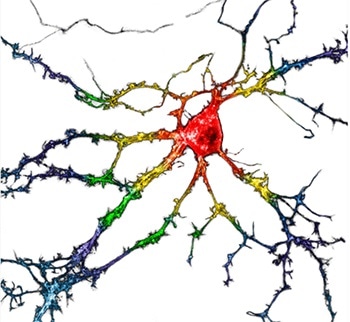Researchers at the University of California, Davis, have created a genetically encoded sensor for detecting hallucinogenic substances. The sensor, called psychLight, may be used to explore potential therapies for mental illness, in neuroscience studies, and to identify illegal drugs.

Dissociated neurons expressing psychLight. Image Credit: Chunyang Dong, Calvin Ly, and Joanne Ly at UC Davis.
The study was published in the journal Cell on April 28th, 2021.
Compounds associated with psychedelic drugs like dimethyltryptamine (DMT) and LSD display great potential to treat conditions like post-traumatic stress disorder, substance use disorder, and depression.
Because of their capacity to quickly modify brain connections, these drugs are known as psychoplastogens. However, drugs that can induce hallucinations must be used with extreme caution and patients must be closely monitored. The “head twitch” assay in rodents is now the most successful method to evaluate an experimental drug to see whether it induces hallucinations.
Scientific studies on psychedelic drugs have been conducted since the 1940s, but we still don’t have an effective cellular assay for them.”
David Olson, Study Co-Author and Assistant Professor, Department of Chemistry, College of Letters and Science, University of California, Davis
Graduate students collaborating with Lin Tian, associate professor at the UC Davis School of Medicine, and Olson’s laboratory contributed to the study.
This collaboration was really driven by graduate students.”
Lin Tian, Associate Professor, School of Medicine, University of California Davis
Tian’s lab creates fluorescent markers for brain neural chemicals like dopamine and serotonin. According to Tian, these neuromodulators cause the brain to respond rapidly to changing circumstances.
Similar to including neuromodulators, both psychedelic drugs and those used to treat mental disorder either imitate or inhibit the activity of these neuromodulators, and hence may have dramatic effects on brain function.
Measuring chemicals in the brain
The serotonin 2A receptor (HT2AR) serves as the foundation for the psychLight biosensor. Serotonin released by neurons and picked up by serotonin receptors on other neurons in the brain controls mood. Both psychedelic drugs and medications used to cure mental illnesses function on the serotonin 2A receptor.
Jason (Chunyang) Dong, a graduate student in Tian’s lab in the Department of Biochemistry and Molecular Biology, collaborated with graduate students Calvin Ly and Lee Dunlap in Olson’s lab to create an altered version of the HT2A receptor with a fluorescent component.
When psychLight attaches to a hallucinogenic ligand or serotonin, its conformation changes, thus increasing the fluorescence. Non-hallucinogenic ligands may also attach to psychLight, but the fluorescence profile is distinct.
PsychLight can be used by researchers to examine how biologically occurring neuromodulators, such as hallucinogenic drugs or serotonin, impact different regions of the brain.
They may also use it to test for potential drugs that stimulate the HT2A receptor and induce hallucinations. When psychLight is expressed in cells, which are then exposed to a hallucinogenic substance, the cell cultures light up. Tian claims that the sensor can be used to search for pharmaceutical potential without causing side effects of hallucinations.
High-throughput screening
The researchers created a high-throughput method to scan compounds for hallucinogenic activity and binding to the HT2A receptor using cells expressing psychLight. Thus, they demonstrated that AAZ-A-154, a previously untested drug, inhibits the receptor but is not hallucinogenic. Subsequent studies in animal models indicated that AAZ-A-154 has antidepressant potential.
Seven Biosciences, started by Tian and former graduate student Grace Mizuno, is collaborating with UC Davis InnovationAccess to patent and commercialize the psychLight technology. Olson’s company, Delix Therapeutics, is working on AAZ-A-154 and plans to use the psychLight assay to find new pharmaceutical drugs.
Source:
Journal reference:
Dong, C., et al. (2021) Psychedelic-inspired drug discovery using an engineered biosensor. Cell. doi.org/10.1016/j.cell.2021.03.043.